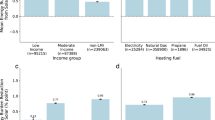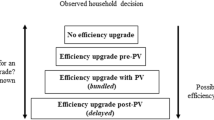Abstract
Rooftop and community solar are alternative product classes for residential solar in the United States. Community solar, where multiple households buy solar from shared systems, could make solar more accessible by reducing initial costs and removing adoption barriers for renters and multifamily building occupants. Here we test whether community solar has expanded solar access in the United States. On the basis of a sample of 11 states, we find that community solar adopters are about 6.1 times more likely to live in multifamily buildings than rooftop solar adopters, 4.4 times more likely to rent and earn 23% less annual income. We do not find that community solar expands access in terms of race. These differences are driven, roughly evenly, by inherent differences between the two solar products and by policies to promote low-income community solar adoption. The results suggest that alternative solar products can expand solar access and that policy could augment such benefits.





Similar content being viewed by others
Data availability
This work was performed using proprietary, household-level data that cannot be shared. However, elements of the rooftop solar data are publicly available from the Lawrence Berkeley National Laboratory at https://emp.lbl.gov/projects/solar-demographics-trends-and-analysis. Aggregated data are available in via Github at https://github.com/eoshaugh2/community_solar_access. The LIFT Solar Toolkit used in the imputed carve outs analysis (Methods) is publicly available at https://lift.groundswell.org/solar-projects/.
Code availability
Code used in this analysis is available via Github at https://github.com/eoshaugh2/community_solar_access.
Change history
28 June 2024
A Correction to this paper has been published: https://doi.org/10.1038/s41560-024-01586-8
References
Davis, M. et al. US Solar Market Insight: 2022 Year in Review (Wood Mackenzie, 2023).
Sunter, D., Castellanos, S. & Kammen, D. Disparities in rooftop photovoltaics deployment in the United States by race and ethnicity. Nat. Sustain. 2, 71–76 (2019).
Lukanov, B. & Krieger, E. Distributed solar and environmental justice: exploring the demographic and socio-economic trends of residential PV adoption in California. Energy Policy 134, 110935 (2019).
Darghouth, N., O’Shaughnessy, E., Forrester, S. & Barbose, G. Characterizing local rooftop solar adoption inequity in the US. Environ. Res. Lett. 17, 034028 (2022).
Forrester, S., Barbose, G., O’Shaughnessy, E., Darghouth, N. & Crespo Montañés, C. Residential Solar-Adopter Income and Demographic Trends: 2023 Update (Lawrence Berkeley National Laboratory, 2023).
Carley, S. & Konisky, D. M. The justice and equity implications of the clean energy transition. Nat. Energy 5, 569–577 (2020).
Heeter, J., Sekar, A., Fekete, E., Shah, M. & Cook, J. J. Affordable and Accessible Solar for All: Barriers, Solutions, and On-Site Adoption Potential (NREL, 2021).
Attanasio, O. P. & Pistaferri, L. Consumption inequality. J. Econ. Perspect. 30, 3–28 (2016).
Welton, S. & Eisen, J. Clean energy justice: charting an emerging agenda. Harvard Environ. Law Rev. 43, 307–371 (2019).
Bidwell, D. & Sovacool, B. Uneasy tensions in energy justice and systems transformation. Nat. Energy 8, 317–320 (2023).
Zhou, S., Gao, X., Wellstead, A. M. & Min Kim, D. Operationalizing social equity in public policy design: a comparative analysis of solar equity policies in the United States. Policy Stud. J. 51, 741–772 (2023).
Drury, E. et al. The transformation of southern California’s residential photovoltaics market through third-party ownership. Energy Policy 42, 681–690 (2012).
O’Shaughnessy, E., Barbose, G., Wiser, R., Forrester, S. & Darghouth, N. The impact of policies and business models on income equity in rooftop solar adoption. Nat. Energy 6, 84–91 (2021).
Malhotra, R. Increasing access to solar for low-income households in multifamily affordable housing. In Proceedings of the American Solar Energy Society National Conference (eds Ghosh, A. K. & Rixham, C.) 87–93. (Springer, 2022).
Goyette, K. L. Community solar policy and the low- and moderate-income customer. Nat. Res. Environ. 36, 13–16 (2021).
Funkhouser, E., Blackburn, G., Magee, C. & Rai, V. Business model innovations for deploying distributed generation: the emerging landscape of community solar in the U.S. Energy Res. Social Sci. 10, 90–101 (2015).
Hausman, N. How Community Solar can Benefit Low- and Moderate-Income Customers (World Resources Institute, 2022).
Heeter, J., Bird, L., O’Shaughnessy, E. & Koebrich, S. Design and Implementation of Community Solar Programs for Low- and Moderate-Income Customers (NREL, 2018).
Abbott, S., Tyson, M., Popkin, M. & Farthing, A. Community Solar+: How the Next Generation of Community Solar can Unlock New Value Streams and Help Communities Pursue Holistic Decarbonization (Rocky Mountain Institute, 2022).
Michaud, G. Perspectives on community solar policy adoption across the United States. Renew. Energy Focus 33, 1–15 (2020).
Brown, M., Soni, A., Lapsa, M. V., Southworth, K. & Cox, M. High energy burden and low-income energy affordability: conclusions from a literature review. Progr. Energy 2, 042003 (2020).
Haynes, B. Community Solar: Expanding Access and Safeguarding Low-Income Families (National Consumer Law Center, 2024).
Shared Renewables Policy Catalog (Interstate Renewable Energy Council, 2020).
Equitable Access to Community Solar: Program Design and Subscription Considerations (NREL, 2021).
Xu, K., Sumner, J., Dalecki, E. & Burton, R. Expanding Solar Access: State Community Solar Landscape (NREL, 2023).
Borenstein, S. & Davis, L. The distributional effects of U.S. clean energy tax credits. Tax Policy Econ. 30, 191–234 (2016).
Chwastyk, D., Leader, J., Cramer, J. & Rolph, M. Community Solar Program Design Models (Smart Electric Power Alliance, 2018).
Gallucci, M. Energy equity: bringing solar power to low-income communities. YaleEnvironment360 https://e360.yale.edu/features/energy-equity-bringing-solar-power-to-low-income-communities (2019).
Lydersen, K. Bringing community solar to low-income customers is harder than it looks. Canary Media https://www.canarymedia.com/articles/solar/bringing-community-solar-to-low-income-customers-is-harder-than-it-looks (2023).
Connelly, C. U.S. Community Solar Market Outlook: 2023 (Wood Mackenzie, 2023).
O’Shaughnessy, E., Barbose, G., Wiser, R. & Forrester, S. Income-targeted marketing as a supply-side barrier to low-income solar adoption. iScience 24, 103137 (2021).
Ramasamy, V. et al. U.S. Solar Photovoltaic System and Energy Storage Cost Benchmarks, with Minimum Sustainable Price Analysis: Q1 2023 (NREL, 2023).
Chan, G. et al. Sharing the Sun Community Solar Project data (December 2022). NREL Data Catalog. NREL https://data.nrel.gov/submissions/220 (2023).
Connelly, C. Demystifying LMI Incentives for Community Solar Projects (Wood Mackenzie, 2023).
DeLiema, M. & Witt, P. Profiling consumers who reported mass marketing scams: demographic characterizations and emotional sentiments associated with victimization. Secur. J. https://doi.org/10.1057/s41284-023-00401-5 (2023).
Khanna, K. et al. wru: who are you? Bayesian prediction of racial category using surname, first name, middle name, and geolocation. R package version 1.0.1. CRAN https://CRAN.R-project.org/package=wru (2022).
Imai, K., Olivella, S. & Rosenman, E. T. R. Addressing census data problems in race imputation via fully Bayesian improved surname geocoding and name supplements. Sci. Adv. 8, eadc9824 (2022).
O’Shaughnessy, E. Rooftop solar incentives remain effective for low- and moderate-income adoption. Energy Policy 163, 112881 (2022).
Statewide distributed solar projects: beginning 2000. NYSERDA https://data.ny.gov/Energy-Environment/Statewide-Distributed-Solar-Projects-Beginning-200/wgsj-jt5f/about_data (2024).
LIFT Solar: solar projects. Groundswell https://lift.groundswell.org/ (2023).
Xu, K., Sumner, J., Burton, R. & Dalecki, E. State policies and programs for community solar. NREL Data Catalog. NREL https://data.nrel.gov/submissions/215 (2023).
Acknowledgements
This material is based upon work supported by the US Department of Energy’s (DOE) Office of Energy Efficiency and Renewable Energy (EERE) under the Solar Energy Technologies Office award number 38444 and contract number DE-AC02-05CH11231 (E.O. and G.B.). This work was authored in part by the National Renewable Energy Laboratory, operated by Alliance for Sustainable Energy, LLC, for DOE under contract number DE-AC36-08GO28308 (S.K. and J.S.). Funding was provided by the DOE Office of Energy Efficiency and Renewable Energy Solar Energy Technologies Office. The views expressed in the article do not necessarily represent the views of the DOE or the US Government. The US Government retains and the publisher, by accepting the article for publication, acknowledges that the US Government retains a non-exclusive, paid-up, irrevocable, worldwide license to publish or reproduce the published form of this work, or allow others to do so, for US Government purposes.
Author information
Authors and Affiliations
Contributions
E.O. wrote the paper and led the analysis; G.B. conceived of the study, supported the analysis and co-led data acquisition; and S.K. and J.S. led data acquisition and supported the analysis.
Corresponding author
Ethics declarations
Competing interests
The authors declare no competing interests.
Peer review
Peer review information
Nature Energy thanks Michael Garvey, Christine Lasco Crago and the other, anonymous, reviewer(s) for their contribution to the peer review of this work.
Additional information
Publisher’s note Springer Nature remains neutral with regard to jurisdictional claims in published maps and institutional affiliations.
Supplementary information
Supplementary Information
Supplementary Tables 1–10 and Figs. 1 and 2.
Rights and permissions
Springer Nature or its licensor (e.g. a society or other partner) holds exclusive rights to this article under a publishing agreement with the author(s) or other rightsholder(s); author self-archiving of the accepted manuscript version of this article is solely governed by the terms of such publishing agreement and applicable law.
About this article
Cite this article
O’Shaughnessy, E., Barbose, G., Kannan, S. et al. Evaluating community solar as a measure to promote equitable clean energy access. Nat Energy 9, 955–963 (2024). https://doi.org/10.1038/s41560-024-01546-2
Received:
Accepted:
Published:
Issue Date:
DOI: https://doi.org/10.1038/s41560-024-01546-2
- Springer Nature Limited





